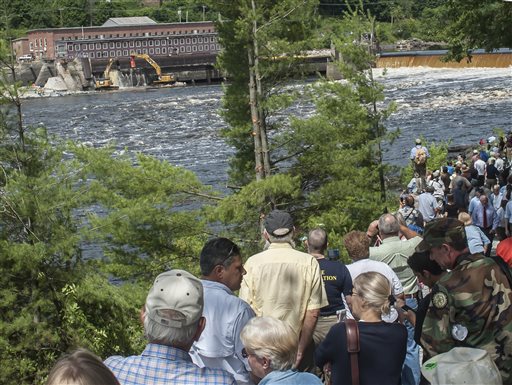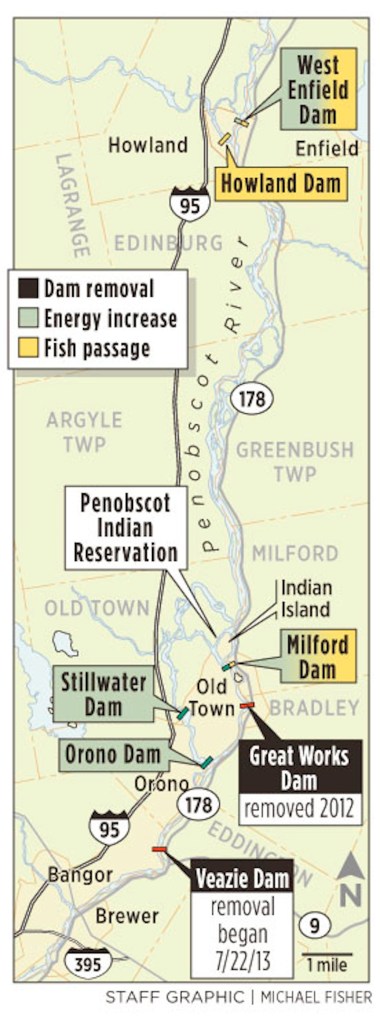EDDINGTON — An excavator equipped with a big jackhammer smashed through the top of the Veazie Dam on Monday morning, sending chunks of concrete and a spray of water tumbling 32 feet to the riverbed below.
“The river seemed to take its breath,” said John Banks, natural resources director of the Penobscot Indian Nation, standing on the bank of the Penobscot River and watching with more than 300 other people. “It said, ‘Ah, freedom. Freedom.”‘
Monday marked the beginning of the end for the 100-year-old Veazie Dam, which was built to generate hydroelectric power and is being removed as part of a historic river restoration project that has gained international attention.
The volume of water flowing through the newly breached dam at first was barely enough for a good shower. By next spring, though, when the entire dam is gone, the Penobscot River will be roaring past here at a rate of more than 660,000 gallons per second.
Because the Great Works Dam 7.3 miles upriver was removed last year, the Milford Dam will then become the first dam on the river; however, crews are now building a state-of-the-art fish elevator there. Farther upriver, crews will build a natural fish passage around at the Howland Dam.
When the $62 million restoration project is completed, fish will have access to prime habitat in the Piscataquis, Mattawamkeag and Pleasant rivers, and the East Branch of the Penobscot River.
Removing the Veazie Dam alone will cost $6.8 million, with funds coming from the federal government and private contributions.
Once the overall project is complete, ocean-going fish, such as alewives and shad, will be able to swim into Maine’s interior as far as Baxter State Park.
And because much of the habitat along the river basin is undeveloped and unpolluted, removing the barriers for migratory fish in the river will have a huge payoff, said Josh Royte, a planner with The Nature Conservancy.
About 12,000 alewife and blueback herring have been counted annually at the Veazie Dam. In few years, millions could pass through here to reach spawning grounds in the lakes and streams of Maine’s interior, scientists say.
In the past, returning salmon captured at the Veazie Dam have been trucked to a state hatchery so their offspring could be distributed by truck to salmon habitat around the river basin.
The project will allow salmon to swim on their own upriver, and it will also improve the survival rates of juvenile salmon, many of whom are killed in hydropower turbines as they swim to sea, said Bill Taylor, president of the Atlantic Salmon Federation based in St. Andrews, New Brunswick.
Because salmon live five to seven years at sea before returning to the river to spawn, it will take that long to see any increase in the population, he said.
Only 624 salmon were counted at Veazie last year. In 20 years, the river should be supporting runs of 10,000 to 12,000 salmon, Taylor said.
Patrick Keliher, commissioner of the Maine Department of Marine Resources, said he has great hopes for the river’s ability to recover.
“While man does his best to knock the snot out of these rivers, they do recover,” he said. “They do heal.”
Since the Great Works Dam was removed last year, there has been no noticeable increase in fish because the Veazie Dam downstream has continued to block fish passage. However, kayakers now enjoy paddling on the new whitewater rapids that emerged after the Great Works Dam was removed and the pond behind it receded. The river now looks natural, Banks said.
Because the Veazie Dam is the first dam on the river, its removal represents the first big step for improving fish access.
In terms of the amount of habitat that would be regained, the entire project is the largest river restoration project in the United States.
The project is seen as a model for river restoration efforts around the world because it was made possible by cooperative agreement among environmental groups, federal agencies, an Indian tribe and a power company.
The agreement improves fish passage while allowing a power company, Black Bear Hydro, to increase power generation at six dams in the river basin, so there will be no net loss of power production.
During negotiations with the power company and federal regulators, the Penobscots used their claim of tribal fishing rights as leverage to improve fish passage. For the power company, the agreement provided the stability it needed to invest in technology that allowed its turbines to work more efficiently.
Developing countries in Africa, Latin America and Asia are eager to build dams to produce cheap power. Environmentalists will never be successful if their only argument is to never build one, said Tom Rumpf, associate state director of The Nature Conservancy.
He said the Penobscot River Restoration Project provides an alternative model: Plan for an entire river basin and build dams in strategic locations so that fish can still access spawning areas.
“You can maintain hydropower and still have tremendous conservation benefits,” he said.
In 1833, when a dam was built at Veazie for the first time to power a sawmill, the Penobscot Indians protested that the dam would destroy the annual runs of salmon and other sea-run fish.
Their complaints went unheeded, even when thousands of shad and alewives the following spring lingered about the new dam and died there, filling the air with a powerful stench.
The sea-run fish that once journeyed up the Penobscot River by the millions to spawn have dwindled to the hundreds. It’s been more than 25 years since the Penobscot Indian Nation formally harvested a salmon for a ceremony.
On Monday, while crews continued to hammer away the dam, Joe Dana, a Penobscot Indian, paddled toward the dam in a birch bark canoe he made with other members of the tribe.
Kirk Francis, chief of the Penobscot Indian Nation, looked on and remarked that most elders never imagined that this day would come.
“Our entire community is ecstatic,” he said. “What this project represents is hope for the future that has been lost for a very long time.”
Tom Bell can be contacted at 791-6369 or at:
Tbell@pressherald.com
Send questions/comments to the editors.






Success. Please wait for the page to reload. If the page does not reload within 5 seconds, please refresh the page.
Enter your email and password to access comments.
Hi, to comment on stories you must . This profile is in addition to your subscription and website login.
Already have a commenting profile? .
Invalid username/password.
Please check your email to confirm and complete your registration.
Only subscribers are eligible to post comments. Please subscribe or login first for digital access. Here’s why.
Use the form below to reset your password. When you've submitted your account email, we will send an email with a reset code.